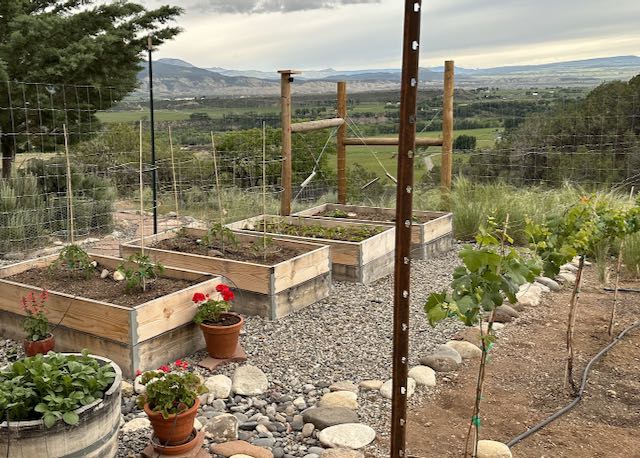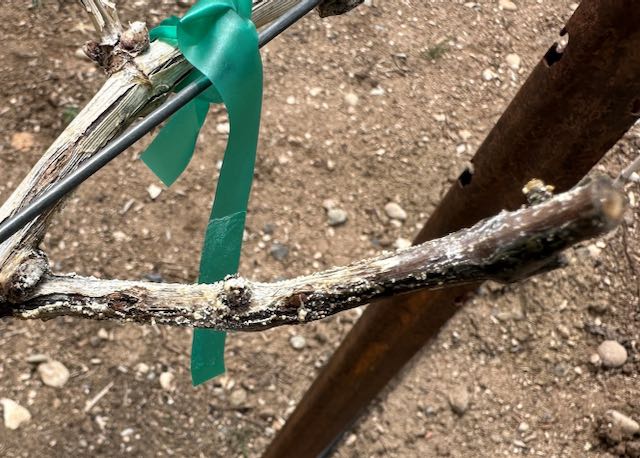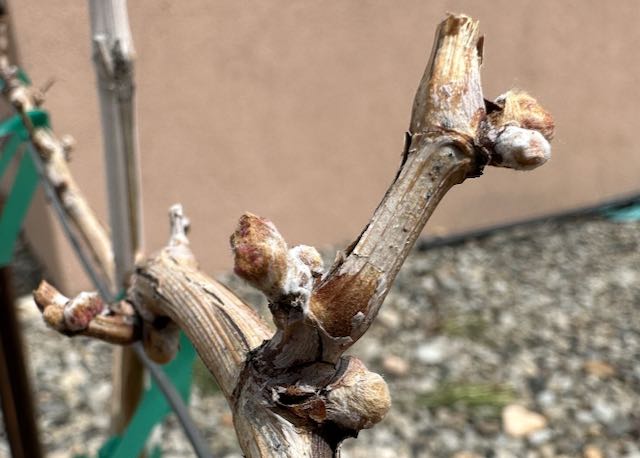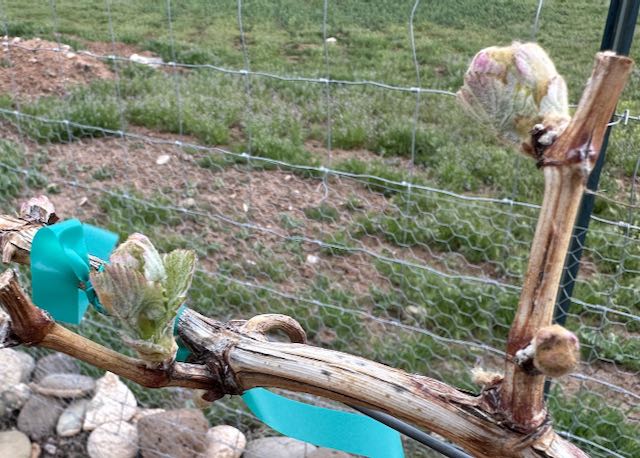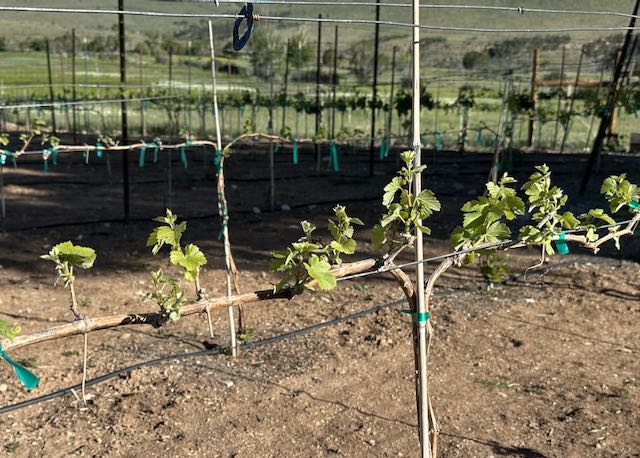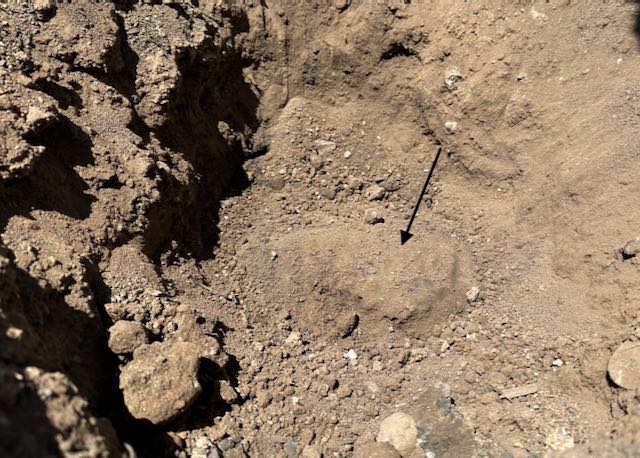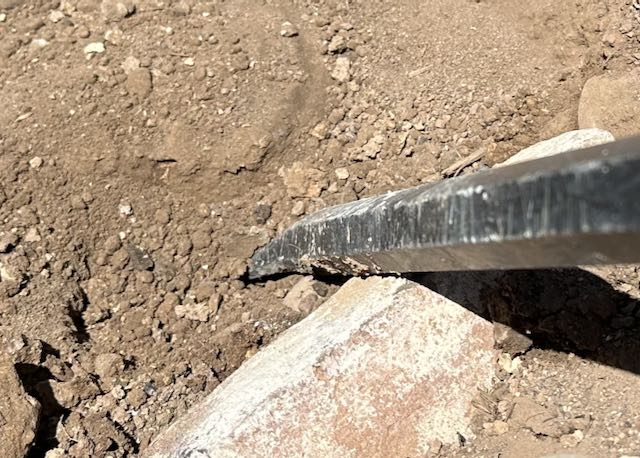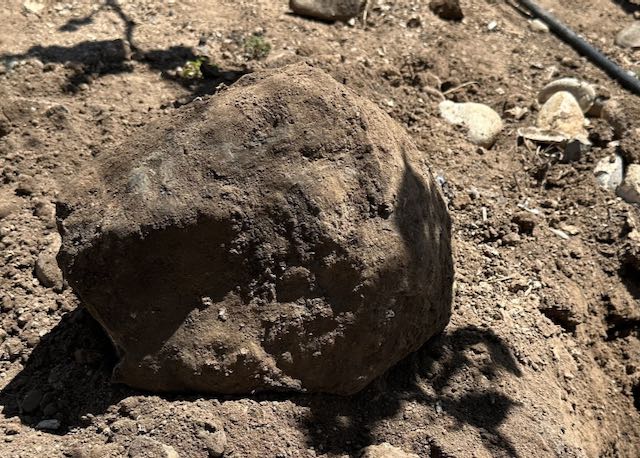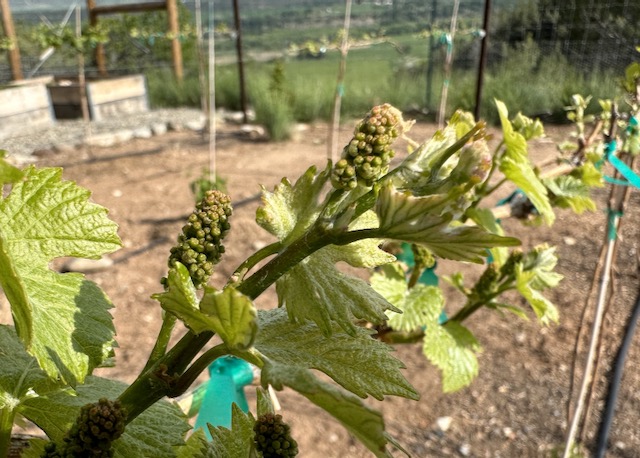
May 2023
May is an exceedingly busy month in the vineyard. You must tend to new growth with vine trellis guiding and pruning, and also prepare for future year vineyard growth with supplemental planting to fill row gaps. Continued weeding is essential, along with beginning a spraying program to control powdery mildew and small critters. On top of that, bottling wine from the 2022 harvest was required, which I had put off since April. We had grandparenting responsibilities in Denver later during the month, the clock was ticking as May began.
As covered in the 2023 April Chronicles, I had pruned two-thirds of the vineyard including all of the Riesling in mid-April. The Riesling buds were beginning to swell slightly and sap was running strong, less so for the Pinot Noir. All of a sudden two nights of hard freezes appeared on the horizon. I halted pruning, believing It prudent to affirm how the already pruned vines did versus the unpruned vines after the freeze. And freeze it did, 28 degrees the first night, 24 the next.
Uncovered via process discovery, the below-freezing temps placed the pruned Pinot bud break on hold for a significant period of up to four weeks. Less time for the unpruned Pinot. While the Riesling bud break may have briefly paused, they quickly “went to the races”. In finishing the Pinot pruning, there was an apparent “nominal growth zone” in the middle of the vineyard consisting of the pre-freeze pruned Pinot. See pics below taken on the same day of the three examples from left to right, pre-freeze pruned Pinot (white substance is dried sap), post-freeze pruned Pinot, and the pre-freeze pruned Riesling.
Lesson learned, prune in February when the sap isn’t running or wait until the likelihood of a hard freeze is past, especially for the Pinot Noir!
Nine days is an eternity in a vineyard during May. Upon returning from our grandparenting escapades, the vines were springing upwards from the cordons along the lower trellis growth wire. New vine bud growth at the bottom of many vines and along trunks was also pushing forward. The new growth required taming, and 12 Riesling grafted rootstock and 12 Pinot had just arrived from Double A Vineyards. The new rootstock had been on-route for five days, and their viability was on the clock. Planting was first up.
Planting the Riesling was straightforward, there were 11 identified spots. Upon counting I had 13 rootstocks (thank you very much), so I kept two in reserve for later. I soaked the rootstock in water for two hours while I dug the holes. Positioning the rootstock in the holes under the trellis wire, filling the holes three-quarters with soil, and watering heavily didn’t take long. I then topped off the soil and added a two-gallon hour drip emitter for each plant.
Pinot planting the next day proved more challenging. There were only open spots for half the rootstock but there were several vines I believed to be dead, either having not survived the winter or the early season prune. I had dug up three of these suspicious vines when a local grower stopped by for a visit. He assisted in helping me think through whether vines actually needed to be replaced. I was primarily examining the vine cordons along the growth wire, which showed no inner green when cut. He used a sharp knife to examine the vine close to the ground, along with identifying close-by small buds. Many vines were just waking up he claimed. Patience was advised. I cut back the lagging vines close to the ground and planted what I could, a total of 10 vines. By the end of May, the vines I thought were dead were beginning to show life. Patience paid off.
I used to tell an early girlfriend of mine (soon-to-be wife!) back in the day that I came from a family of dirt farmers. We joke about that now because I graduated from dirt farming school the past two years and am now working on my master’s in rock farming. One particular Pinot hole I attempted to dig got me close to graduation.
The previous May, my son-in-law assisted with the rootstock planting. There was one spot we abandoned due to several overly large rocks. We covered the partially dug hole and created a small stone mound like a grave marker to indicate the fruitless nature of the spot—a gapping gap in the row. I decided to give it another go, and began to dig to the right of the stone mound. With 15 minutes of effort and patience, I dug around a large stone. The stone wasn’t coming out with the shovel so I brought the 9-pound post-hole bar to bear. Wedging the bar under the stone and using a brick for leverage behind the bar, I was able to loosen the stone and get it out. This by far is the largest stone extracted from the vineyard.
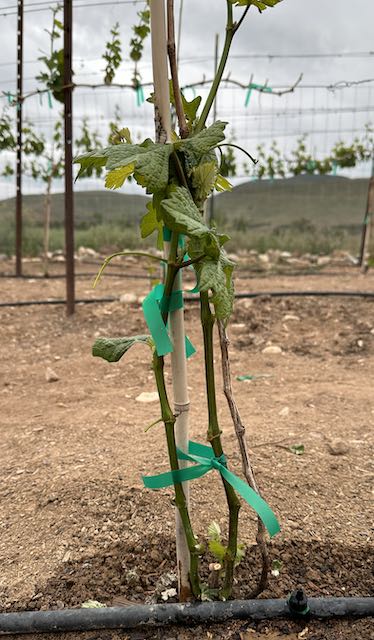
With planting complete, pruning commanded the remainder of my vineyard time in May. It never ceases to amaze how quickly vines grow. I focused on removing buds breaking along the trunks, and pruning back cordon spurs too closely spaced along the growth wire, where baby grape clusters were multiplying (see image heading this post). When possible, I’d encourage and train new strong vine sucker growth along an existing trunk, originating from below the lower graft union at the soil. These can serve as a future trunk should the original trunk have issues the following winter. See adjacent image of two strong new trunks growing along an existing second year trunk.
When pruning, I kept coming across small clear globules, scattered under leaves and along vine spurs where they meet the cordon. Not knowing what they were and worried they could be pest egg sacks of some sort, I took a sample to the local agricultural store, Earth Friendly Supply Company for advice (great team!). While they didn’t know what they were, a local valley grape grower I didn’t know, was in the store and examined my sample. He thought they could be phylloxera eggs. Say what?! The aphid-like pest that destroyed European vineyards in the late 19th Century and put the wine world at that time on hold for many years? Upon my report of the incident to another more educated and experienced local grower, he discovered in discussion with another grower (love the local networks), confirmed with research the culprit—grape pearls—i.e., vine perspiration! A healthy byproduct of the growth process. BTW, phylloxera was eventually controlled (not eliminated), by grafting American grapevine rootstock to European vines. A reason why when planting a new vineyard grafted rootstock should be used, instead of vines taken from cuttings.
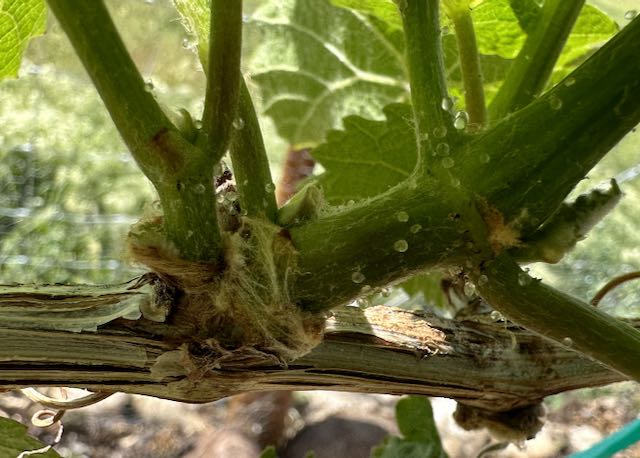
Mistakenly, I didn’t spray for powdery mildew last year, the second season for many of the vines. Some apparent mildew had overwintered on the vines, evidenced by small black splotches along some of the canes and cordons. This year I’d need to be aggressive with a spraying program. A local grower (thank goodness for local growers!) advised the use of organic Stylet Oil early in the season. A technical-grade white mineral oil, it smothers targets working as an insecticide, fungicide, and virus control. I had conducted a first spray in mid-April, it was time for another application. Using a backpack sprayer, the job was accomplished May 31.
We can’t leave the month without a weather report. As highlighted in April’s Chronicles, the year to date had been quite wet. Things began to dry out during May with .23 inches of precipitation, though the weather remained cool, and characteristically windy as illustrated via my vineyard Tempest Weather station. The vineyard experienced several days with wind gusts near and over 20 mph, and a couple of 30+ as well.
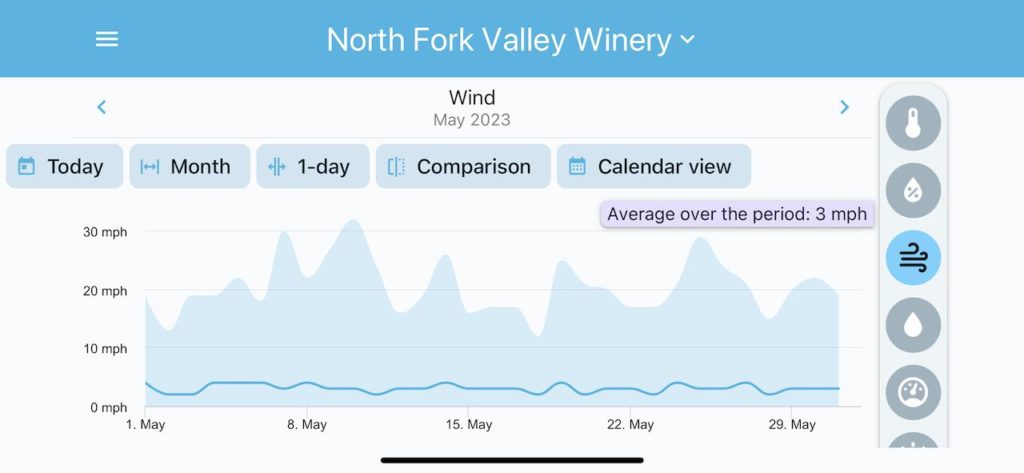
More importantly, for Colorado agriculture and communities including downriver recipients of Colorado water, near end-of-winter-season snowpack was 40% above an average season. The North Fork Valley located in the Gunnison River basin was at 80% above average, accompanied by a 184% snowpack. Numbers like this haven’t been seen in nearly two decades. Thank goodness for the third year of El Nina. We are reaping the benefits. I’m witnessing plants coming out of the ground I’ve never seen in my three years on the property, including plants blooming I didn’t know had the capacity.
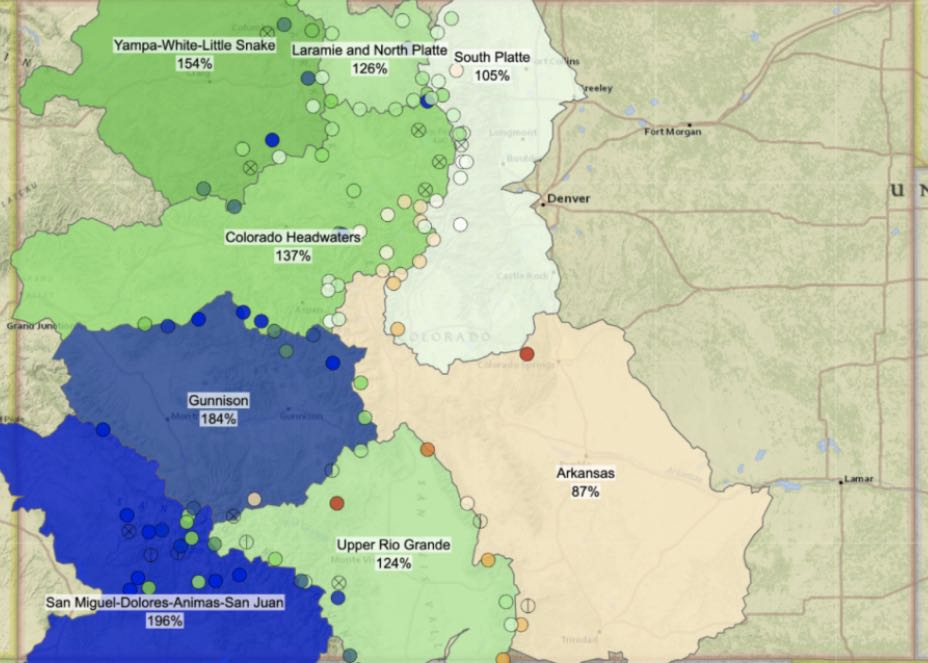
The month was action-packed and busy. I haven’t even disclosed the two cases of Pinot Meunier Rosé I bottled, along with a case of Riesling. All from grapes grown in the valley. Also not covered was the completion of planting and irrigation of seven raised vegetable beds, all within the confines of my 125-vine vineyard. A little paradise I’m working on…
